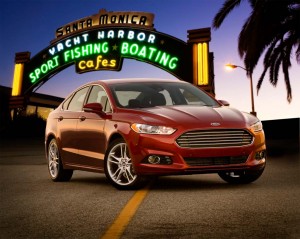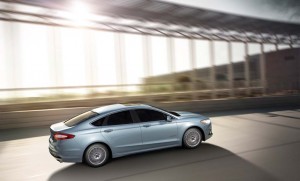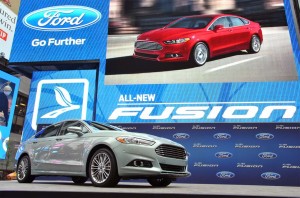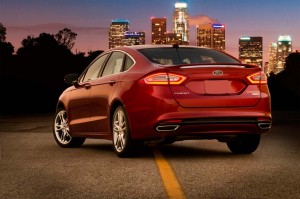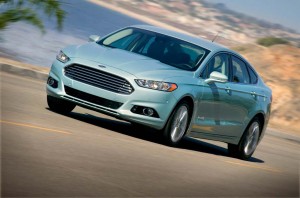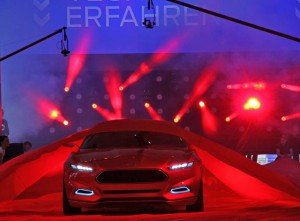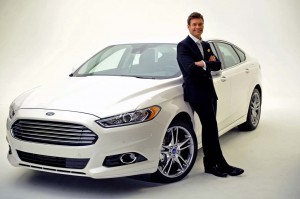The last time Ford dominated the midsize American passenger car market it was selling the original Taurus. Despite that success, the maker quickly seemed to lose focus, shifting its attention to the more profitable SUVs that would soon dominate the U.S. market. It didn’t take long for the Japanese to fill that midsize vacuum, Toyota, with the Camry, and Honda with the Accord, taking a commanding lead for the last quarter century.
But with U.S. fuel prices surging, and buyers suddenly beginning to shift back to passenger cars Detroit has woken up, unleashing an assortment of new and surprisingly competitive models. At the top of that list is the new 2013 Ford Fusion.
The new midsize model has a number of things going for it that could give Ford significant momentum despite the breadth of competition it will face. There’s the fact that the Fusion Hybrid will deliver best-in-class 47 mpg fuel economy that markedly bests the comparable Toyota Camry and falls only 3 mpg short of the vaunted Prius. There’s the range of advanced safety and infotainment features. And then there’s the new Fusion’s striking design.
Like the original, 1986 Taurus, the new Fusion is a stylistic standout in what has long been a sea of blandness. Borrowing heavily from the well-reviewed Ford Evos Concept the 2013 Fusion seems as likely as that first-generation Taurus to set the styling trend for the coming years.
While it abandons the Evos’ impractical gullwing doors it maintains other elements of the show car’s distinctive design cues, including the almost slit-like headlights that are a welcome relief after watching other makers reach almost comic proportions with their oversized, “jewel-like” lamps. There’s a hint of Audi A7 in the coupe-like roofline and the upscale feel is further enhanced by trapezoid grille lifted, near whole, from Ford’s one-time British luxury arm Aston Martin.
The roomy interior has an equally up-market feel. Where Camry is burdened by too many plastic panels that speak of excess cost-cutting, even the base Fusion boasts a rich an well-appointed cabin with well-grained, sumptuous and soft-touch finishes. It’s almost as if Ford and Toyota have reversed their traditional roles.
That’s not to say all is perfect. The Titanium package we drove boasts a high-feature Sony-based infotainment system with the latest version of Ford’s Sync technology. Techies will love it but techno-phobes will be less pleased by the lack of a knob for tuning and the need to work through touchscreen menus to turn down the seat-heaters.
Other versions of the new Fusion, curiously, feature separate tuning knobs and seat-heater switches and, we’re told, Ford may add those seemingly mundane niceties to the top-line Sony system in the near future, as well.
The new Fusion is offered with an assortment of advanced safety features, as well, including AutoPark and a Lane Departure system that can gently nudge the vehicle back into its lane – and even warn a weary driver that it might be time to pull over.
Other features will include blind-spot detection, Cross-Traffic Alert, Hill Start Assist, Active Cruise Control and, on the Fusion Hybrid and Plug-in, even an active noise canceling system working somewhat like the headphones that have become popular with air travelers.
Motorists will be given an unusually broad choice of five different drivetrains for the 2013 Ford Fusion – notably including an updated hybrid that will deliver an impressive and segment-leading 47 miles to the American gallon, a full eight more on the highway and four mpg better in the city than the Toyota Camry Hybrid.
The maker has taken a number of steps to get there, updating its original hybrid drive system – which notably now uses a CVT transmission of Ford’s own design rather than one purchased from Japanese supplier Aisin. And unlike the systems used by Toyota and Honda, Ford has opted to a more energy-dense lithium-ion battery pack. It is both smaller in size and bigger in terms of the energy it stores than the nickel-metal hydride pack in the old Fusion, allowing the sedan to recapture and store more power, directly improving fuel efficiency.
A plug-in hybrid will follow later in the model-year and is expected to more than double that fuel economy number to somewhere in the range of 100. Unlike the Chevrolet Volt which gets about 35 miles per charge, however, what Ford will call the Fusion Energi is expected to get somewhere around 15 miles in pure electric mode.
The vast majority of buyers are expected to opt for any of three conventional petrol powertrains, whether the base 2.5-liter, the downsized 1.6-liter EcoBoost or the premium 2.0-liter EcoBoost, a turbocharged package that, while not segment-leading, delivers an impressive balance of fuel efficiency, at 33 miles per U.S. gallon on the highway and 22 in the city; and power, at 240 hp and 275 lb-ft of torque.
That translates into near V-6 acceleration when you need it but four-cylinder fuel efficiency when you’re just cruising. Unlike Detroit’s traditional I-4 powertrains – which have a tendency to be rough and noisy – the 2.0-liter EcoBoost is smooth and surprisingly quiet under normal driving conditions with a refined exhaust note under wide-open throttle.
The engine’s refined behavior is matched by reasonably solid road manners. Steering is precise and confident enough you might forget it’s electric-assist, with a light feel at parking lot speeds and notably less boost on open roads.
The suspension, meanwhile, is well-planted and responsive, especially considering the less than sporty manners of most of Fusion’s competitors.
We also had a brief drive in the 1.6-liter EcoBoost version of the 2013 Ford Fusion and found that higher-mileage offering nearly as impressive. While acceleration is understandably less aggressive the trade-off is still better fuel economy – which reaches a full 37 mpg on the Highway in versions equipped with the 6-speed manual. Mileage drops to 36 with the automatic – unless you pay another $295 for the optional auto stop/start system.
That hybrid-derived technology automatically shuts the engine off when you’re idling at a stoplight or in a fast food line then fires it back up when you lift your food off the brake. By Ford’s estimate the typical motorist should reduce fuel consumption by 3.5% with the feature, though auto stop/start can yield as much as 10%, it predicts, in heavy urban use.
To our pleasant surprise, the stop/start system is delightfully transparent — especially when compared to the disruptive version in the new BMW 3-Series.
Fuel economy is one of the big battlegrounds in the 2013 midsize sedan segment. And with the launch of the Fusion Hybrid Ford is hoping to capture the high ground. With the conventional 1.6-liter engine, it lags just one mpg behind Nissan Altima.
But mileage alone won’t determine success in the competitive segment – which also includes the new Honda Accord and Chevrolet Malibu and another version of the Toyota Camry which was itself updated for 2012. And Ford is clearly hoping that with its range of features and its striking design it will move up in the segment pecking order.
If there’s a downside, Ford also has one of the more expensive models, though the list of standard features should soften the blow. The 2.0-liter EcoBoost version we drove came in at $25,950.
On the whole, Fusion is a pleasantly appealing surprise, a car that meets or exceeds what you might expect in the mainstream midsize sector, whether you’re looking at fuel economy, features or road manners. Add the striking good looks and Ford has a new sedan that more than rivals the best-in-class and anything it has brought to market since the first Taurus.

